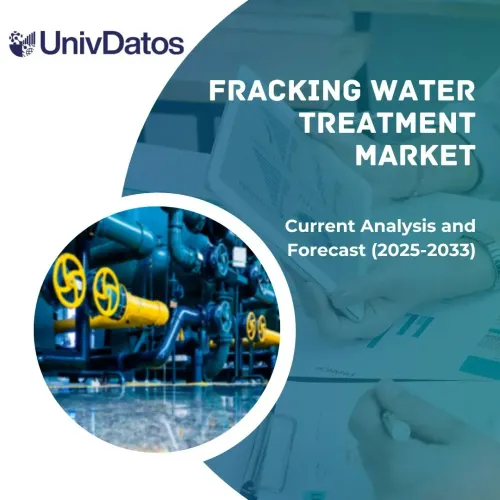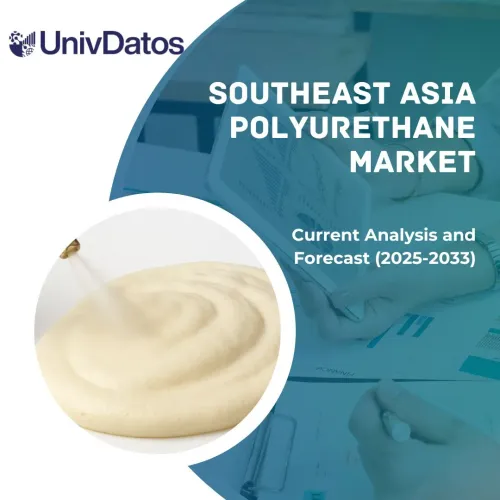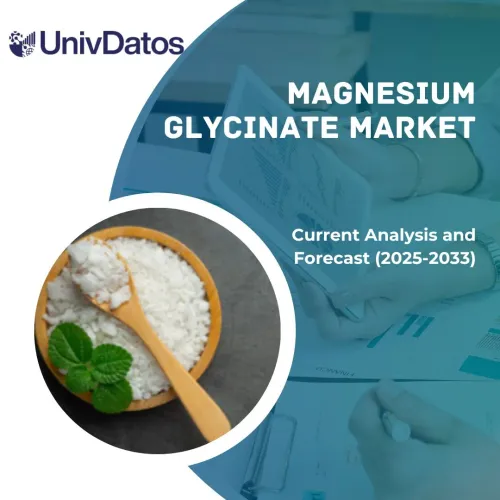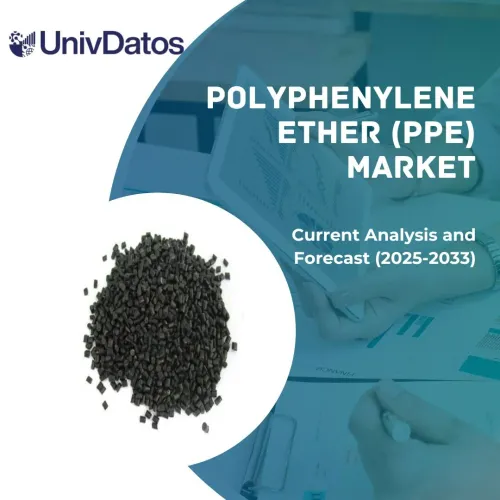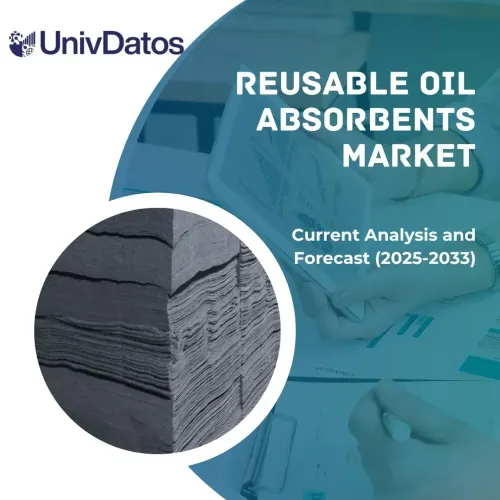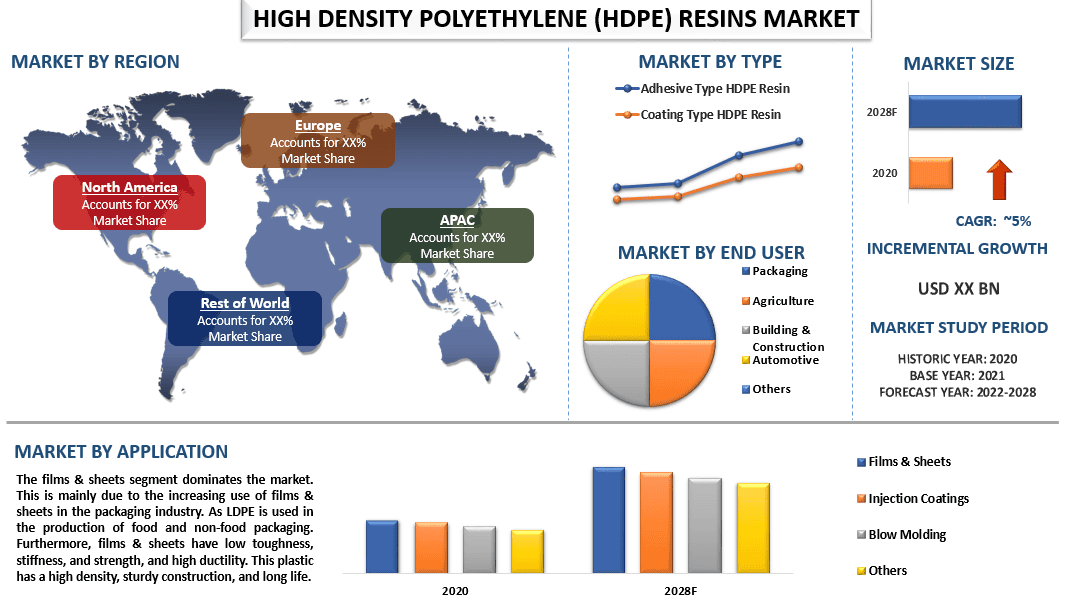 전 세계 고밀도 폴리에틸렌(HDPE) 수지 시장은 예측 기간 동안 약 5%의 상당한 성장률을 보일 것으로 예상됩니다. HDPE 수지는 우유통, 세제병, 쓰레기 봉투와 같은 제품을 만드는 데 사용되는 고밀도 폴리에틸렌 플라스틱입니다. HDPE는 튼튼하고 내구성이 뛰어나 내구성이 필요한 제품에 이상적인 소재입니다. 고밀도 폴리에틸렌(HDPE) 수지 시장은 식음료 산업의 강력한 수요로 인해 증가할 것으로 예상됩니다. 이와 함께 저렴한 원자재의 용이한 접근성과 일회용 플라스틱에 대한 규제 강화로 인한 전 세계 다용도 플라스틱에 대한 높은 수요 또한 고밀도 폴리에틸렌(HDPE) 수지 시장의 성장을 촉진하는 데 중요한 역할을 할 것으로 예상됩니다. 예를 들어, 2020년 11월 INEOS Olefins and Polymers USA는 Gemini HDPE LLC의 Sasol 지분 50%를 인수하고 자산의 100% 소유주가 되는 것에 대한 기본 조건에 합의했다고 발표했습니다. Gemini는 바이모달 고밀도 폴리에틸렌 제품의 수탁 제조업체입니다. 고밀도 폴리에틸렌(HDPE) 수지 시장은 필름 제조에 사용이 증가하고 식용 제품의 유통 기한을 늘리는 데 중점을 두면서 긍정적으로 증가할 것으로 예측됩니다.
전 세계 고밀도 폴리에틸렌(HDPE) 수지 시장은 예측 기간 동안 약 5%의 상당한 성장률을 보일 것으로 예상됩니다. HDPE 수지는 우유통, 세제병, 쓰레기 봉투와 같은 제품을 만드는 데 사용되는 고밀도 폴리에틸렌 플라스틱입니다. HDPE는 튼튼하고 내구성이 뛰어나 내구성이 필요한 제품에 이상적인 소재입니다. 고밀도 폴리에틸렌(HDPE) 수지 시장은 식음료 산업의 강력한 수요로 인해 증가할 것으로 예상됩니다. 이와 함께 저렴한 원자재의 용이한 접근성과 일회용 플라스틱에 대한 규제 강화로 인한 전 세계 다용도 플라스틱에 대한 높은 수요 또한 고밀도 폴리에틸렌(HDPE) 수지 시장의 성장을 촉진하는 데 중요한 역할을 할 것으로 예상됩니다. 예를 들어, 2020년 11월 INEOS Olefins and Polymers USA는 Gemini HDPE LLC의 Sasol 지분 50%를 인수하고 자산의 100% 소유주가 되는 것에 대한 기본 조건에 합의했다고 발표했습니다. Gemini는 바이모달 고밀도 폴리에틸렌 제품의 수탁 제조업체입니다. 고밀도 폴리에틸렌(HDPE) 수지 시장은 필름 제조에 사용이 증가하고 식용 제품의 유통 기한을 늘리는 데 중점을 두면서 긍정적으로 증가할 것으로 예측됩니다.
Dow, LG화학, LyondellBasell Industries Holdings B.V., SABIC, Exxon Mobil Corporation, BASF SE, Chevron Phillips Chemical Company LLC, Braskem, Formosa Plastics Corporation, Qatar Petrochemical Company (QAPCO) Q.P.J.S.C. 등이 시장의 주요 업체입니다. 이러한 업체들은 하이테크 및 혁신적인 제품/기술로 고객을 용이하게 하기 위해 파트너십과 함께 여러 M&A를 수행해 왔습니다.
보고서에 제시된 인사이트
"유형 중 코팅 유형 HDPE 수지가 예측 기간 동안 상당한 CAGR로 성장합니다"
유형에 따라 시장은 접착 유형 HDPE 수지와 코팅 유형 HDPE 수지로 분류됩니다. 코팅 유형 HDPE 수지는 예측 기간 동안 상당한 CAGR로 성장합니다. 코팅 유형의 고밀도 폴리에틸렌 수지는 코팅 재료로 사용됩니다. 강력한 충격 저항과 우수한 수분 차단 특성을 제공합니다. 코팅 유형 HDPE 수지는 뛰어난 특성으로 인해 식품 포장 산업에서 자주 사용됩니다.
"응용 분야 중 필름 및 시트가 예측 기간 동안 상당한 CAGR로 성장합니다"
응용 분야에 따라 시장은 필름 및 시트, 사출 코팅, 블로우 성형 등으로 분류됩니다. 필름 및 시트는 예측 기간 동안 상당한 CAGR로 성장합니다. 이는 주로 포장 산업에서 필름 및 시트의 사용이 증가하기 때문입니다. 필름 및 시트는 인성, 강성 및 강도가 낮고 연성이 높습니다. 이 플라스틱은 밀도가 높고 구조가 튼튼하며 수명이 깁니다. 따라서 불투명하다는 특성으로 인해 튜브, 용기, 버블러, 투약 병 및 성형 실험실 장비 제조에도 사용됩니다. 따라서 이러한 모든 요소가 시장 성장에 기여하고 있습니다.
"북미가 시장에서 상당한 점유율을 차지했습니다"
2020년 북미는 전 세계 고밀도 폴리에틸렌(HDPE) 수지 시장에서 상당한 점유율을 차지했습니다. 고밀도 폴리에틸렌 수지 판매 및 공급은 해당 지역과 전 세계에 있는 주요 소비자 산업의 영향을 받습니다. 또한 의료, 식음료 및 화학 물질을 포함한 산업의 수요 증가로 인해 포장은 해당 지역의 가장 큰 시장입니다. NIST에 따르면, 2021년에 제조업은 미국 GDP에 2조 3천억 달러를 기여하여 미국 전체 GDP의 12.0%를 차지했습니다.
이 보고서를 구매해야 하는 이유:
- 이 연구에는 인증된 주요 산업 전문가가 검증한 시장 규모 및 예측 분석이 포함되어 있습니다.
- 이 보고서는 전체 산업 성과에 대한 빠른 검토를 한눈에 제공합니다.
- 이 보고서는 주요 비즈니스 재무, 제품 포트폴리오, 확장 전략 및 최근 개발에 중점을 두고 주요 산업 동료에 대한 심층 분석을 다룹니다.
- 산업에 만연한 동인, 제약, 주요 추세 및 기회에 대한 자세한 검토.
- 이 연구는 다양한 세그먼트에 걸쳐 시장을 포괄적으로 다룹니다.
- 산업에 대한 심층적인 지역 수준 분석.
맞춤화 옵션:
전 세계 고밀도 폴리에틸렌(HDPE) 수지 시장은 요구 사항 또는 기타 시장 세그먼트에 따라 추가로 맞춤화할 수 있습니다. 이 외에도 UMI는 귀하가 고유한 비즈니스 요구 사항을 가지고 있음을 이해하므로 귀하의 요구 사항에 완벽하게 맞는 보고서를 얻기 위해 언제든지 저희에게 연락하십시오.
목차
고밀도 폴리에틸렌(HDPE) 수지 시장 분석(2022-2028)을 위한 연구 방법론
글로벌 고밀도 폴리에틸렌(HDPE) 수지 시장의 과거 시장 분석, 현재 시장 추정, 미래 시장 예측은 전 세계 주요 지역에서 고밀도 폴리에틸렌(HDPE) 수지의 채택을 분석하고 평가하기 위해 수행된 세 가지 주요 단계였습니다. 과거 시장 수치를 수집하고 현재 시장 규모를 추정하기 위해 광범위한 2차 조사를 수행했습니다. 둘째, 이러한 통찰력을 검증하기 위해 수많은 결과와 가정이 고려되었습니다. 또한 글로벌 고밀도 폴리에틸렌(HDPE) 수지 시장의 가치 사슬 전반에 걸쳐 업계 전문가들과 광범위한 1차 인터뷰도 진행되었습니다. 1차 인터뷰를 통해 시장 수치를 가정하고 검증한 후, 전체 시장 규모를 예측하기 위해 상향식/하향식 접근 방식을 사용했습니다. 그 후, 업계와 관련된 세분 시장 및 하위 세분 시장의 시장 규모를 추정하고 분석하기 위해 시장 세분화 및 데이터 삼각 측정 방법이 채택되었습니다. 자세한 방법론은 아래에 설명되어 있습니다.
과거 시장 규모 분석
1단계: 2차 자료에 대한 심층 연구:
연례 보고서 및 재무제표, 실적 발표, 보도 자료 등과 같은 회사 내부 자료와 저널, 뉴스 및 기사, 정부 간행물, 경쟁사 간행물, 부문 보고서, 타사 데이터베이스 및 기타 신뢰할 수 있는 간행물을 포함한 외부 자료를 통해 고밀도 폴리에틸렌(HDPE) 수지 시장의 과거 시장 규모를 파악하기 위해 자세한 2차 연구를 수행했습니다.
2단계: 시장 세분화:
고밀도 폴리에틸렌(HDPE) 수지 시장의 과거 시장 규모를 파악한 후, 주요 지역에 대한 다양한 세분 시장 및 하위 세분 시장에 대한 과거 시장 통찰력과 점유율을 수집하기 위해 자세한 2차 분석을 수행했습니다. 주요 세분 시장은 유형, 응용 분야 및 최종 사용자로 보고서에 포함되어 있습니다. 또한 해당 지역에서 테스트 모델의 전반적인 채택을 평가하기 위해 국가 수준 분석을 수행했습니다.
3단계: 요인 분석:
다양한 세분 시장 및 하위 세분 시장의 과거 시장 규모를 확보한 후, 고밀도 폴리에틸렌(HDPE) 수지 시장의 현재 시장 규모를 추정하기 위해 자세한 요인 분석을 수행했습니다. 또한 다양한 유형, 응용 분야 및 고밀도 폴리에틸렌(HDPE) 수지의 최종 사용자와 같은 종속 변수와 독립 변수를 사용하여 요인 분석을 수행했습니다. 전 세계 고밀도 폴리에틸렌(HDPE) 수지 시장 부문에서 상위 파트너십, 인수합병, 사업 확장 및 제품 출시를 고려하여 수요 및 공급측 시나리오에 대한 철저한 분석을 수행했습니다.
현재 시장 규모 추정 및 예측
현재 시장 규모 산정: 위 3단계의 실행 가능한 통찰력을 바탕으로 현재 시장 규모, 글로벌 고밀도 폴리에틸렌(HDPE) 수지 시장의 주요 업체, 세분 시장의 시장 점유율을 파악했습니다. 필요한 모든 비율 점유율 분할 및 시장 세분화는 위에서 언급한 2차 접근 방식을 사용하여 결정되었으며 1차 인터뷰를 통해 검증되었습니다.
추정 및 예측: 시장 추정 및 예측을 위해 이해 관계자가 사용할 수 있는 동인 및 추세, 제약 조건 및 기회를 포함한 다양한 요인에 가중치를 부여했습니다. 이러한 요인을 분석한 후, 관련 예측 기술, 즉 상향식/하향식 접근 방식을 적용하여 전 세계 주요 시장에서 다양한 세분 시장 및 하위 세분 시장에 대한 2028년 시장 예측을 도출했습니다. 시장 규모를 추정하기 위해 채택된 연구 방법론은 다음과 같습니다.
- 수익(USD) 측면에서 업계의 시장 규모와 국내 주요 시장에서 고밀도 폴리에틸렌(HDPE) 수지 시장의 채택률
- 시장 세분 시장 및 하위 세분 시장의 모든 비율 점유율, 분할 및 세분화
- 제공되는 제품 측면에서 글로벌 고밀도 폴리에틸렌(HDPE) 수지 시장의 주요 업체. 또한 빠르게 성장하는 시장에서 경쟁하기 위해 이러한 업체가 채택한 성장 전략
시장 규모 및 점유율 검증
1차 연구: 주요 지역에서 최고 경영진(CXO/VP, 영업 책임자, 마케팅 책임자, 운영 책임자, 지역 책임자, 국가 책임자 등)을 포함한 주요 오피니언 리더(KOL)와 심층 인터뷰를 진행했습니다. 그런 다음 1차 연구 결과를 요약하고 제시된 가설을 증명하기 위해 통계 분석을 수행했습니다. 1차 연구의 입력은 2차 연구 결과와 통합되어 정보를 실행 가능한 통찰력으로 전환했습니다.
다양한 지역의 1차 참가자 분할
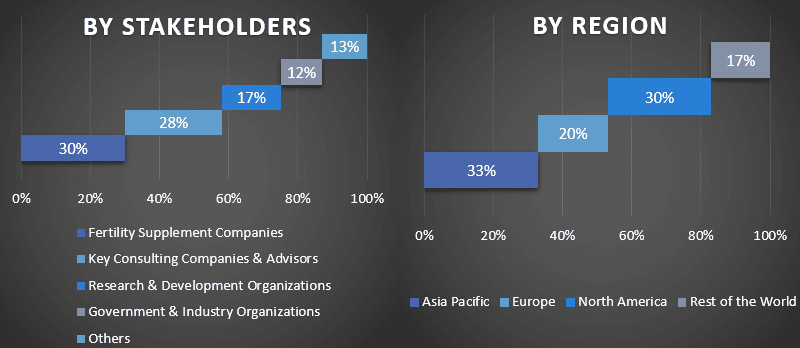
시장 엔지니어링
데이터 삼각 측량 기술을 사용하여 전체 시장 추정을 완료하고 글로벌 고밀도 폴리에틸렌(HDPE) 수지 시장의 각 세분 시장 및 하위 세분 시장에 대한 정확한 통계 수치를 도출했습니다. 글로벌 고밀도 폴리에틸렌(HDPE) 수지 시장에서 유형, 응용 분야 및 최종 사용자의 영역에서 다양한 매개변수와 추세를 연구한 후 데이터를 여러 세분 시장 및 하위 세분 시장으로 분할했습니다.
글로벌 고밀도 폴리에틸렌(HDPE) 수지 시장 조사의 주요 목표
글로벌 고밀도 폴리에틸렌(HDPE) 수지 시장의 현재 및 미래 시장 동향이 연구에서 정확히 지적되었습니다. 투자자는 연구에서 수행된 정성적 및 정량적 분석을 기반으로 투자에 대한 재량권을 확보하기 위한 전략적 통찰력을 얻을 수 있습니다. 현재 및 미래 시장 동향은 지역 수준에서 시장의 전반적인 매력도를 결정하여 산업 참가자가 미개척 시장을 활용하여 선점자 이점을 누릴 수 있는 플랫폼을 제공했습니다. 연구의 다른 정량적 목표는 다음과 같습니다.
- 가치(USD) 측면에서 고밀도 폴리에틸렌(HDPE) 수지 시장의 현재 및 예측 시장 규모를 분석합니다. 또한 다양한 세분 시장 및 하위 세분 시장의 현재 및 예측 시장 규모를 분석합니다.
- 연구의 세분 시장에는 유형, 응용 분야 및 최종 사용자의 영역이 포함됩니다.
- 고밀도 폴리에틸렌(HDPE) 수지에 대한 규제 프레임워크를 정의하고 분석합니다.
- 다양한 중개자의 존재와 관련된 가치 사슬을 분석하고 산업의 고객 및 경쟁사 행동을 분석합니다.
- 주요 지역에 대한 고밀도 폴리에틸렌(HDPE) 수지 시장의 현재 및 예측 시장 규모를 분석합니다.
- 보고서에서 연구된 지역의 주요 국가에는 아시아 태평양, 유럽, 북미 및 기타 국가가 포함됩니다.
- 고밀도 폴리에틸렌(HDPE) 수지 시장의 회사 프로필과 빠르게 성장하는 시장에서 지속하기 위해 시장 참여자가 채택한 성장 전략
- 산업에 대한 심층적인 지역 수준 분석
관련 보고서
이 상품을 구매한 고객님들도 함께 구매하신 상품




